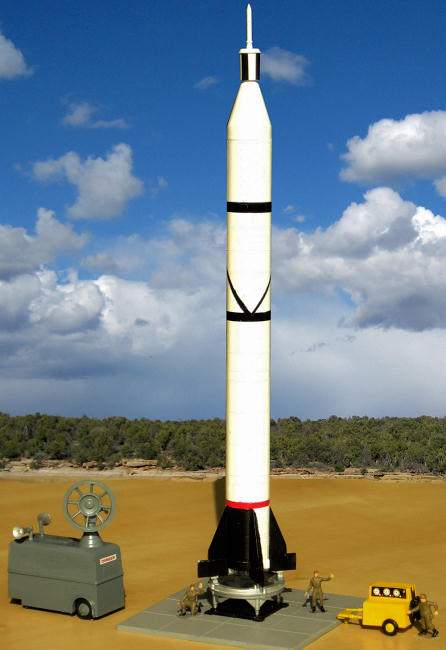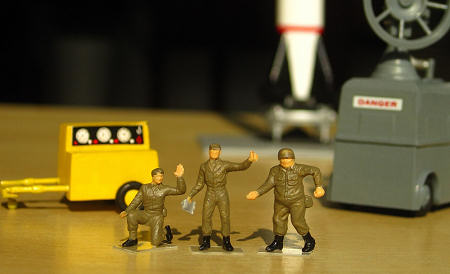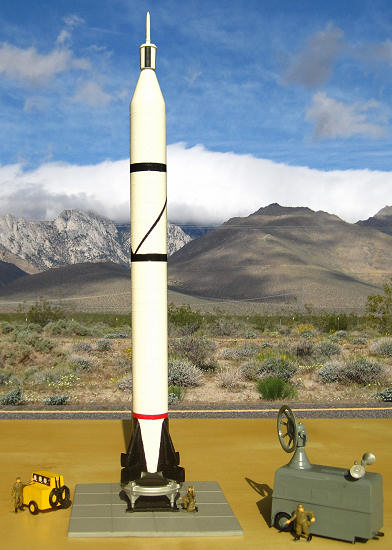Lodela/Revell 1/110 Jupiter C
|
KIT #: |
RH-1832 |
|
PRICE: |
$ |
|
DECALS: |
One option |
|
REVIEWER: |
Richard F. |
|
NOTES: |
Vintage rules! |

 Pointy little Explorer 1 was the first US
satellite, launched a year after the Soviets got humanity off to a
flying start in the Space Age by launching Sputniks 1 and 2 in 1957.
With the instruments in this satellite, American scientists discovered
the Van Allen radiation belts. Thanks to that, a whole niche industry of
nutjob conspiracy theorists are convinced man never went to the moon.
They'd have fried up there, man!
Pointy little Explorer 1 was the first US
satellite, launched a year after the Soviets got humanity off to a
flying start in the Space Age by launching Sputniks 1 and 2 in 1957.
With the instruments in this satellite, American scientists discovered
the Van Allen radiation belts. Thanks to that, a whole niche industry of
nutjob conspiracy theorists are convinced man never went to the moon.
They'd have fried up there, man!
Explorer 1 flew into space atop the relatively puny Juno 1, a variant of
the Jupiter C rocket which essentially looked the same. This rocket came
from the world of 1950s Intermediate Range Ballistic Missiles (IRBM). It
was Jupiter rockets based in Turkey that played a role in the Cuban
Missile Crisis of 1962. The Juno 1 had an extra, fourth stage tucked
inside the top.
Fully fueled and loaded, a Juno 1 weighed 29 metric tonnes. Most of it
was fuel. The end result of all those fireworks was a 14 kg satellite
orbiting Earth. Explorer 1 functioned for about 5 months until its power
ran out. It stayed in orbit for about 12 years.
Modeling Madness previewed a very similar kit
right here.
Mine doesn't include the massive gantry, but instead comes with three
ground crew and two little service trailers.
It also comes with a Redstone, another early American rocket. The one in
the kit is not to be confused with the later Mercury-Redstone, which
actually looks more like this Jupiter.
For a kit so old, this is actually pretty nice. Gently raised detail on
the rockets is complemented by well-done little ground crew. The Jupiter
rocket is better than the Redstone in the sense that it doesn't seem so
simplified.
Frank Spahr did an amazing job of his Jupiter rocket and gantry, which
you can see
right here.
Mine is potentially a bit more modest.
Well, building a rocket ain't rocket science. Not a model one, anyway.
You take your left half, you take your right half, glue 'em tog ether.
Stick the nose cone on and boom! There's your rocket. The fit of this
rocket wasn't terrible but it wasn't amazing. And, of course, you are
left with two long seams to deal with while avoiding losing too much
surface detail. The new Dragon rocket kits recently previewed and built
here on MM go together in tubular sections rather than halves. Much
smarter. (The Dragon Mercury-Redstone represents a rocket that shared
the bottom two thirds of the Jupiter, in shape at least).
ether.
Stick the nose cone on and boom! There's your rocket. The fit of this
rocket wasn't terrible but it wasn't amazing. And, of course, you are
left with two long seams to deal with while avoiding losing too much
surface detail. The new Dragon rocket kits recently previewed and built
here on MM go together in tubular sections rather than halves. Much
smarter. (The Dragon Mercury-Redstone represents a rocket that shared
the bottom two thirds of the Jupiter, in shape at least).
I had more fun assembling the service equipment. There's a caravan with
a radar on top and two big horns which I guess must be either
loudspeakers or giant klaxons to warn of imminent launch. There's a
smaller piece of equipment with some coiled hoses on it and a control panel with dials that are bigger than the biggest pizza when scaled up.
These both go together easily although I misplaced the tow-bar on the
yellow trolley so I faked up a new one using some spare parts.
Returning to the rocket, I did the best I could with the seams, and then
prepared to paint it.
There are three army guys in this kit. I've named one of them Sgt L.
Ardo. See if you can guess which he is.
 Both rockets come with US Army stencils and also decals to make the
stripes around the rocket bodies. These decals were unusable, though,
having yellowed pretty badly. That's ok, because the Juno that launched
explorer didn't have US Army printed on it anyway. I looked at some
pictures, including Frank's build, and masked up and painted some black
and red stripes. I had less success with the diagonal stripes that go
round the fuselage.
Both rockets come with US Army stencils and also decals to make the
stripes around the rocket bodies. These decals were unusable, though,
having yellowed pretty badly. That's ok, because the Juno that launched
explorer didn't have US Army printed on it anyway. I looked at some
pictures, including Frank's build, and masked up and painted some black
and red stripes. I had less success with the diagonal stripes that go
round the fuselage.
On the payload area at the top (or what I assume is the payload area) I
used some black decal stripe from another kit to put four vertical
stripes in place.
At the bottom, I copied a Jupiter rocket I saw at the Kennedy Space
Center's "Rocket Garden" and made the black-and-white sections along the
same lines.
Vintage kits are fun!
Richard F.
March 2012
If you would like your product reviewed fairly and fairly quickly, please contact the editor or see other details in the
Note to
Contributors.
Back to the Main Page
Back to the Review
Index Page